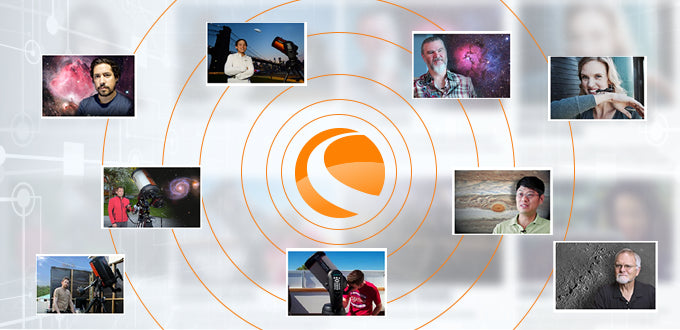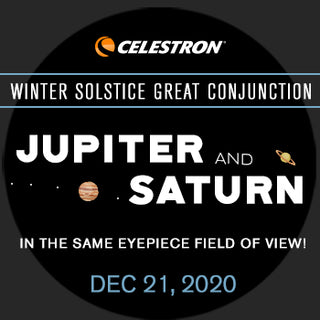Try These 12 Things with Your New Telescope
February 1, 2021

It's a big Universe out there, and your first night out with a new telescope can be daunting if you aren't sure what to observe. Our experts compiled this list of the top 12 targets for beginners. Aim your telescope at any one of them for a dazzling introduction to the hobby of astronomy.
SOLAR SYSTEM OBJECTS
 1. THE MOON
1. THE MOON
Luna, our Moon—it's big, bright, and visible almost every night of the year. What better place to embark on your astronomical adventure? Spend one lunar cycle (the time between two New Moons, about 29.5 days), gazing at the Moon night after night. You'll notice changes in the details of its craters and maria, especially along the terminator—the line between dark and light on the lunar surface.
Ready to learn more? Download Team Celestron member Robert Reeves' free ebook, Lunar Landscapes. In it, this master lunar imager takes you on a guided tour of the Moon's most fascinating features. You could also consider investing in a Map of the Moon for more detailed explorations.
Challenge yourself: Observe a complete lunar cycle and sketch what you see every night. Then, turn your sketches into your own lunar calendar to reference for years to come.
 2. JUPITER
2. JUPITERThe King of the Planets is relatively easy to locate in the sky. This gas giant is a large, bright target perfect for any size telescope or binocular. Look for the prominent cloud bands (the dark stripes), the zones (the lighter regions), the four Galilean moons, and the Great Red Spot (visible in larger telescopes).
Check out our Ultimate Guide to Observing Jupiter for observing tips and our favorite accessories to enhance your view.
Challenge yourself: Look through your telescope and try to see if you can find all four of Jupiter's Galilean moons. Can you name them?
 3. SATURN
3. SATURNThe second-largest gas planet in our Solar System, Saturn is another easy object to locate. You'll instantly know you've found it when you spot its breathtaking system of rings.
In 2017, the rings appeared wide open, 27 degrees as seen from Earth. Since then, they have slowly appeared to decrease in angle. By 2025, they'll be edge-on and—because they are so thin—will virtually disappear, leaving Saturn looking like a lonely orb. Gradually, the rings will reopen until they reach maximum tilt again in 2032. We've got lots more info about the ringed giant in our Ultimate Guide to Observing Saturn.
Challenge yourself: Study Saturn's rings and try to find the divisions between them. There are seven rings in all, visible through very large telescopes. But smaller telescopes can reveal Cassini's division, a dark line of demarcation separating the inner and outer rings.
 4. VENUS & MARS
4. VENUS & MARSEarth's neighboring planets are favorite targets for amateur astronomers. Both planets are bright and visible in any size telescope. Like the Moon, you can watch Venus go through its phases from crescent to full. On Mars, you'll be able to pick out features like polar ice caps, maria, and dust storms.
Become an expert on Mars and Venus with our Ultimate Guide to Observing Mars and Ultimate Guide to Observing Venus.
Challenge yourself: See if you can distinguish the northern and/or southern polar ice caps on Mars. Become an early riser and observe Venus as the "morning star" before or shortly after sunrise.
 5. COMETS
5. COMETSAt any given moment, there are several faint comets in the night sky. Still, most of them can only be seen by huge, professional telescopes. Bright comets like Hale-Bopp and NEOWISE are relatively uncommon, but they're a thrill worth waiting for. A great way to hunt for comets is to use a planetarium app like SkySafari. It can alert you to any comets visible on the night you are observing.
Want to learn how to observe a comet? Watch this video by Product Manager Lance Lucero about Comet NEOWISE, which graced the skies in the summer of 2020.
Challenge yourself: If you own a computerized telescope, see if you can slew it to a comet’s coordinates or rough star neighborhood. Then scan the region for a faint, fuzzy “star” with a tail.
 6. THE SUN
6. THE SUNIMPORTANT NOTE: Before viewing the Sun, you MUST equip your telescope with a safe solar filter certified to the latest ISO standards. The filter should cover the entire aperture of your telescope. Do NOT use an eyepiece filter or Herschel wedge. Viewing the Sun without a proper solar filter will cause permanent, irreversible damage to your eyes and your equipment.
With the proper solar filter, the star at the center of our Solar System is a fantastic object to observe with your telescope. The surface of the Sun is constantly changing. Depending on the current activity on the Sun’s surface, you could see one or more sunspots. Check spaceweather.com to see how many sunspots are currently active, then find them in your scope. You can also find out when the next total or partial solar eclipse will take place in your area.
Challenge yourself: Hunt for sunspots! They make great targets for visual observation or astroimaging with a planetary camera.
BEYOND THE SOLAR SYSTEM: DEEP-SKY OBJECTS
While some deep-sky objects are visible from the city, traveling to a dark location will dramatically improve your views. Find out more about magnitude and light pollution and how these factors can affect the quality of your viewing.

Set your sights on the Great Orion Nebula, also known as M42. Due to its brightness and size, the Orion Nebula is visible in any telescope. You can also try the Eskimo and Crab Nebulae. Check your computerized telescope’s hand control or a planetarium app for the location of these objects.
NOTE: If you live in the Southern Hemisphere, try viewing the Great Carina Nebula, NGC 3372.
Challenge yourself: Find all 110 objects in the Messier Catalog. Some may be easier to see than others. The lower an object's magnitude, the easier it will be to view.
 8. GALAXIES
8. GALAXIESA galaxy is a gravitationally bound system of stars, stellar remnants, interstellar gas, dust, and dark matter. There are 4 types of galaxies: spiral, lenticular, elliptical, and irregular. While some galaxies are small and faint, others are breathtaking in beginner telescopes, especially the Andromeda Galaxy. You can also observe our own galaxy, the Milky Way, by panning across it with a wide field telescope under dark skies.
Challenge yourself: Try to see two or more galaxies at once in your eyepiece or camera's field of view.
 9. GLOBULAR CLUSTERS
9. GLOBULAR CLUSTERSGlobular clusters are spherical collections of stars that orbit a galactic core. The gravitational bonds within clusters give these objects their unique shape and density in the center. Our Milky Way Galaxy is full of globular clusters. Check your computerized telescope’s hand control or a planetarium app to find out which ones are visible from your location.
Here are some of our favorites: M13, M5, M3 and M92 in the Northern Hemisphere and Omega Centauri, M13, 47 Tuc, and M22 from the Southern Hemisphere.
Challenge yourself: Observe and compare several globular clusters. Identify what makes each of them unique.
 10. OPEN STAR CLUSTERS
10. OPEN STAR CLUSTERSAn open star cluster is a group of up to a few thousand stars formed from the same giant molecular cloud that are still loosely gravitationally bound to each other. Our favorite is M45, also known as the Pleiades, the Seven Sisters, and Subaru. Some others to look for: M16 and Caldwell 14, which contains NGC 869 and NGC 884.
Challenge yourself: While navigating from one Open Star Cluster to the next, pan the constellation(s) in which each is located for other deep-sky objects.
TRY ASTROPHOTOGRAPHY
 11. CAPTURE AN ASTROIMAGE WITH YOUR SMARTPHONE
11. CAPTURE AN ASTROIMAGE WITH YOUR SMARTPHONEAdvancements in smartphone camera technology have empowered astroimagers around the world to capture pictures of celestial objects and instantly share them with friends.
The process couldn’t be easier. Simply add a smartphone adapter to your telescope, make sure that it is centered on the eyepiece, and start imaging! Play with your phone’s camera settings to dial in the best results. Pro tip: Use a remote shutter release or timer to avoid shaking the camera when you press the on-screen button.
With video calling and live streaming, you can even share the view through your telescope in real time!
Challenge yourself: Add different color filters to your eyepiece, take a couple of pictures of the same object with each, and then use phone apps or computer software to overlay the images for enhanced detail.
 12. CAPTURE AN ASTROIMAGE WITH A DSLR OR ASTRONOMY CAMERA
12. CAPTURE AN ASTROIMAGE WITH A DSLR OR ASTRONOMY CAMERA If you have a DSLR or astroimaging camera, try attaching it to your telescope. To use a DSLR, you will need a few basic accessories, which you can find here. For information on how to attach a camera to your telescope, watch Product Manager Lance Lucero’s demonstration here.
Challenge yourself: If you have either a DSLR or an astroimaging camera, point it toward a planet or a deep-sky object like the Orion Nebula. If you have both a DSLR and an astroimaging camera, image the same object with each camera and determine which one provides the best results.


























